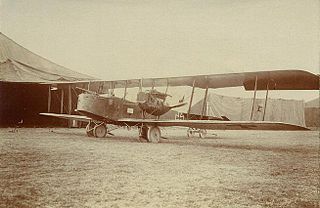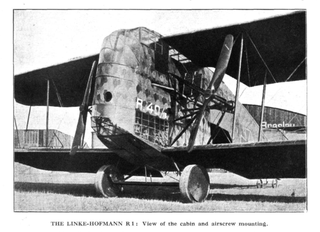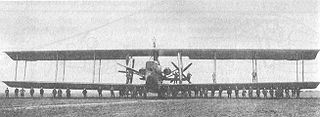
The Gotha G.V was a heavy bomber used by the Luftstreitkräfte during World War I. Designed for long-range service and built by Gothaer Waggonfabrik AG, the Gotha G.V was used principally as a night bomber.

The AEG G.I was a three-seat, twin-engined German biplane bomber aircraft of World War I. It was tested and found to be viable for air-fighting in the latter half of 1915 but performed poorly, necessitating the development of the AEG G.II.

The AEG G.IV was a biplane bomber aircraft designed and produced by the German aircraft manufacturer Allgemeine Elektrizitäts-Gesellschaft. It saw action during the First World War with the Luftstreitkräfte.

The Zeppelin-Staaken R.VI was a four-engined German biplane strategic bomber of World War I, and the only Riesenflugzeug design built in any quantity.

The Friedrichshafen G.III was a heavy bomber designed and manufactured by Flugzeugbau Friedrichshafen. They were used by the German Imperial Air Service during World War I for tactical and limited strategic bombing operations. After the end of the war a number of Friedrichshafen bombers were converted into transport aircraft while a small number also saw service as dedicated airliners.

The Dornier Do 214 was a proposed large long-range flying boat, developed by Dornier in World War II.

The Friedrichshafen G.II was a heavy bomber aircraft that was designed and manufactured in Germany during World War I by Flugzeugbau Friedrichshafen. The plane was used by the Luftstreitkräfte for tactical and limited strategic bombing operations.

The Friedrichshafen G.IV and G.V respectively were heavy bombers that were designed and manufactured in Germany during World War I by Flugzeugbau Friedrichshafen. The G.IV saw limited use by the Luftstreitkräfte for tactical and limited strategic bombing operations, while the G.V and a follow-on design, the FF.62 did not fly until after the Armistice.

The Gotha G.IV was a heavy bomber used by the Luftstreitkräfte during World War I. It was the first mass-produced relatively large airplane.

The Linke-Hofmann R.I was a heavy bomber aircraft designed and built by the German company Linke-Hofmann during World War I. Only four were built and the type never saw service with the Luftstreitkräfte.

The Linke-Hofmann R.II was a bomber aircraft designed and built in Germany from 1917.
The DFW R.I,, was a prototype German bomber aircraft of World War I.

The DFW R.II was a German bomber aircraft of World War I. It was developed at a request by the Luftstreitkräfte in spring 1917 after their experience with the R.I had been generally positive, but only two were ever built despite six being ordered.

The Siemens-Schuckert R.VIII was a bomber aircraft designed and built in Germany from 1916.
The Siemens-Schuckert R.V was a bomber aircraft built in Germany during World War I. It was one of six aircraft based on the Siemens-Schuckert R.I that were originally intended to be identical, but which each developed in a different direction and were designated as different aircraft types by the German Inspectorate of Flying Troops. Development of the R.V benefited from the experience that Siemens-Schuckert and the Idflieg had gained with the R.II, R.III, and R.IV, particularly in its choice of powerplants, where the R.V was spared from the troublesome Maybach HS engine. Between September 1916 and February 1917, the aircraft saw service on the Eastern Front before it was damaged in an accident and dismantled for spare parts.

The Siemens-Schuckert R.VII was a bomber aircraft built in Germany during World War I. It was one of six aircraft based on the Siemens-Schuckert R.I that were originally intended to be identical, but which each developed in a different direction and were designated as different aircraft types by the German Inspectorate of Flying Troops.

The Zeppelin-Staaken R.XVI(Av) was a very large bomber (Riesenflugzeug), designed and built in Germany during 1918.
The Zeppelin-Staaken R.VII was six-engined large bomber - a Riesenflugzeug - of Imperial Germany, intended to be less vulnerable than the airships in use at the time.

The Zeppelin-Staaken R.V was one of a series of large bombers called Riesenflugzeugen, intended to be less vulnerable than the rigid airships in use at the time.

The Zeppelin-Staaken Riesenflugzeuge were a series of very large bomber aircraft - Riesenflugzeuge, usually powered by four or more engines, designed and built in Germany from 1915 to 1919.

















